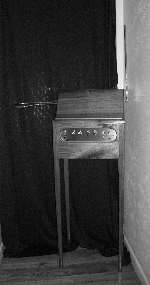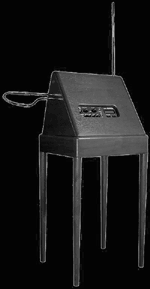
What Is A Theremin?
The Hoge Bio
Home
|
What is the theremin?
The theremin is the only musical instrument you play without touching.
The theremin was one of the very first electronic instruments. It was invented
in Russia around 1919 by Lev Termen. During his time in the United States
he was called Leon Theremin and the instrument took on his name.
It consists of a box-like body with two antennas: one is a straight vertical
rod which controls the pitch (usually on the right for right-handed players),
the other is a horizontal loop (usually on the left) shaped somewhat like
a cane handle which controls the volume. The pitch and volume of the note
are controlled by the distance of the hands from the antennas which generate
an electromagnetic field.

New Wavefront Classic
|

Old Moog EtherVox
|
Moving the hand closer to the pitch antenna causes the pitch to raise, and
moving the hand closer to the volume loop decreases the volume and eventually
silences the instrument. The theremin is tuned by distance not by pitch.
Any motion of the body or any solid object in the playing fields will affect
the note. The fields extend outward about four feet. For this reason thereminists
generally need to be set a little bit away from any other performers.
There have been many different designs, Moog Music remains the longest continuous
builder of theremins and their instruments are the most used by thereminsts
around the world. Without Bob Moog, the theremin might not have survived
as a living musical instrument, his articles have inspired many other builders
and hobbyists. In the early days RCA worked with Lev to mass produce theremins
for home use. But the depression hit and only a few were actually made.
The theremin is a monophonic instrument, i.e. it only plays one note at
a time. It has a very wide range, aprox. eight plus octaves. The timber
(quality of the sound) is usually set by the individual player and combined
with their playing style can yield a wide variety of sonic qualities ranging
from sounding like the human voice or cello or clarinet to something from
outer space. The theremin can also be used to control other electronic instruments,
or can be processed using effects, and is used by non-melodic sound-scape
artists as well as lyric precision players.
Internally the classic theremin contains coils of tightly wound wire that
act as radio frequency oscillators. It is the resultant difference between
two pitch coils (a.k.a. heterodyne or beat frequency),that produces the
pitch of the note. One pitch coil is a fixed oscillator and the other one
is variable and controlled by the pitch rod antenna. The volume coil generates
the loudness control signal, it is connected to the volume loop antenna.
Some "theremin-like" instruments may only have the pitch antenna, or none
at all. But to most serious thereminists they are not thought of as classic
theremins.
The theremin was originally used to play classical music, transcriptions
and original compositions. Lev Termen and his students performed classics
both as solos and ensemble pieces. In the mid-20s Clara Rockmore, then a
young violinist, met him and soon became the greatest player of the theremin.
She devised a new technique for the theremin that made possible virtuosic
performances and her work and concretizing established the theremin as a
serious instrument at the time. Clara only played theremins that Lev custom
built for her, and would not indulge in making "noises" being focused on
professional concert repertoire.
In the popular music realm, Samuel Hoffman mastered the instrument and featured
it in specialty big band numbers. Later the theremin was discovered by film
composers and was used an integral part of such scores as Spellbound and
The Day the Earth Stood Still. But it became type cast as a spooky sound
effect and eventually was used non musically in hundreds of B movies. Hoffman
enjoyed a great career as the principal thereminist of Hollywood. As a side
note the theremin was *not* used in the Beach Boys classic Good Vibrations.
A tactile theremin-based instrument played with a sliding knob, called
the Tannerin, was used in that song.
Over the past ten years the theremin has enjoyed a tremendous resurgance
and has been popping up in countless rock bands, home made videos, performance
pieces and on the sympnonic concert stage. Having the most simple and elegent
playing interface of any instrument of the electric age, Lev's invention
continues to delight and inspire people around the world.
|

